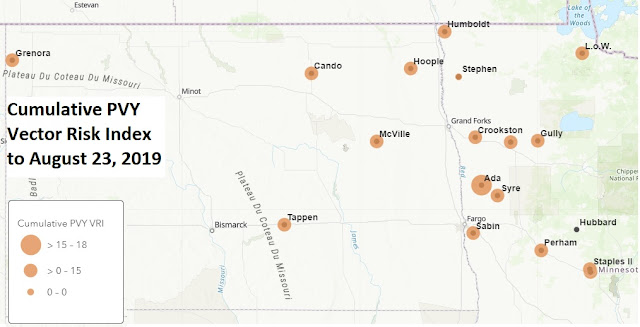Trap Catches Identified to July 17, 2020.
The number of aphid vectors remains low this week with only 12 vectors caught in from 7 sites in the 14 sites reporting this week. We still don't have green peach aphid (cross your fingers that this keeps up!). Potato aphids are still showing up in a number of locations, so I'm keeping the picture of these long-legged aphids up this week. The data's below in the graphs.
The PVY Vector Risk Index is very similar to this time last year, in fact, the numbers. We captured more aphids from more species by this time last year but the species were not as effective at vectoring PVY as the ones being recovered this year, so the Vector Risk Index remains similar.
Even though numbers are low, aphids are flying. Which means we do have movement of aphids from other cropping systems into potatoes. If you're not already, it's time to be scouting seed (and commercial) potatoes for aphids.
Remember though, the aphids you don't see may be as important in transmitting PVY as the ones you do see. Non-colonizing aphid vectors can be as important in spreading PVY as are many of the colonizing species. Colonizing aphids feed on potatoes, they'll start feeding after testing a plant for suitability as a host. Non-colonizing aphids may not spend as much time on individual potato plants as do colonizing aphids; they don't feed on potatoes, so they probe, potentially picking up PVY if it's an infected plant, and quickly move on to another potato plant in the field.
Aphid Fact of the Week - Aphid reproduction in the summer is parthenogenetic, unfertilized females giving rise to female offspring. In fact, in the aphid species we monitor, there are no males during the summer. Adult females give birth to live daughters, which, sometimes in as short a period as several days, will be giving birth to their own daughters. This system can result in very rapid development of aphid colonies.
If you have a field where Colorado Potato Beetle aren’t being controlled by insecticides, please let us know. We’d like to get samples of that population to test for insecticide resistance. Contact Ian MacRae at 218-280-9887.
As always, keep on scouting!
Click on any image below for full-scale version.
Cumulative PVY Vector Risk Index to July 17, 2020.
Cumulative PVY Vector Risk Index for 2019 (for comparison)
Aphid Species Capture and PVY Vector Risk Index for the week ending July 17, 2020
Cumulative Aphid Species Capture and PVY Vector Risk Index to July 17, 2020.



































